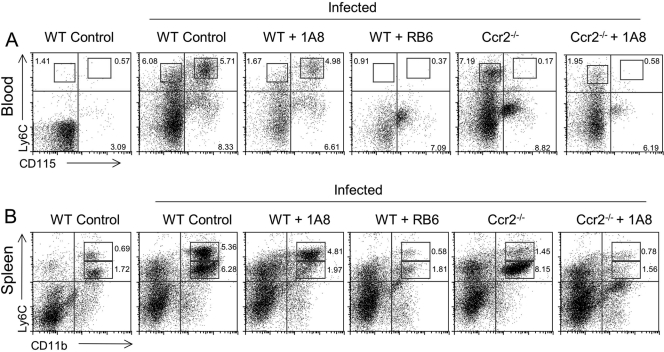FIG. 2.
Depletion of monocytes and neutrophils in the peripheral blood and spleen of mice treated with neutralizing antibodies and infected with T. gondii. (A) Characterization of circulating blood leukocyte subsets by flow cytometry. Inflammatory monocytes (Ly6Chi and CD115+) and neutrophils (Ly6Cint and CD115−) were defined by the indicated boxes (numbers represent percentages of cells). (B) Characterization of leukocyte subsets from the spleen using flow cytometry. Inflammatory monocytes (Ly6Chi and CD11b+) and neutrophils (Ly6Cint and CD11b+) were defined by the indicated boxes (numbers represent percentages of cells). Elevated levels of inflammatory monocytes and neutrophils were present in the blood and spleen of infected control mice (wild-type [WT] control infected) compared to those of noninfected mice (WT control noninfected). 1A8 treatment of control (WT + 1A8) and Ccr2−/− (Ccr2−/− + 1A8) mice reduced neutrophil numbers by 3-fold, resulting in levels similar to those of noninfected controls. RB6-8C5 treatment (WT + RB6) efficiently depleted both inflammatory monocytes and neutrophils. Infected Ccr2−/− mice (Ccr2−/−) lacked inflammatory monocytes, but neutrophils were present in higher numbers, similar to those of infected control mice. Antibodies were applied every day from day 0 to 5 after infection, and cells were isolated at day 6. Experiments were repeated three times, with 2 animals in each group. Plots are the results obtained from representative animals from one experiment.

